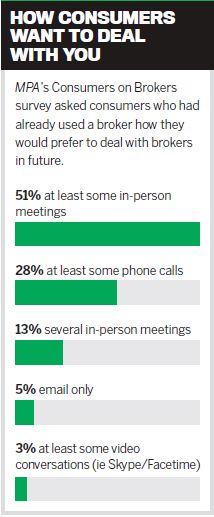With remuneration in the balance, cost control has become a big issue for brokers. MPA talks to several technology providers who can help you save time and money where it counts

With remuneration in the balance, cost control has become a big issue for brokers. MPA talks to several technology providers who can help you save time and money where it counts

As small businesses with limited resources, brokerages have always needed to treat new technology with caution. However, the changes to remuneration discussed by the recent ASIC and Sedgwick reviews suggest that at least some brokers’ incomes could be cut. All the major banks and several of the non-majors have now committed to Recommendation 18 of the Sedgwick review, to decouple commission from loan size by 2020, if not earlier.
The problem for brokers is that large loans often mean large workloads. As David Hustwaite of Aqua Financial Services told MPA, “higher net worth clients will generally have more complex lending needs – for example cross-collateralisation; more complex structures; and their goals may need to be addressed with niche products, such as for doctors and lawyers.”
For brokerages with slim margins, time-consuming deals may end up costing a broker in a very real sense. Luckily, technology is making it possible to drastically cut down the time you spend on applications. In this article we’ve talked to technology providers across the application process who can save you time with minimum investment or training required, giving your brokerage a critical advantage in the stormy waters ahead.
Identification
The supposedly simple act of borrower identification has long presented major challenges for brokers and borrowers, ZipID founder Sean Simmons says. “Forty percent of the time the processing team are having to ask questions and go back to collect more information. What that’s doing is adding half an hour of touch time and maybe holding up the broker’s deal, and maybe requiring the customer to do more to get clearance.”
ZipID has two different solutions to this problem. The first is a full ID service, using Toll employees to identify customers on their doorsteps. This service has been eagerly adopted by the new wave of online brokers, such as Lendi, ISelect and Uno, Simmons explains, as these brokers have no face-to-face interaction with clients.
For brokers who meet clients, ZipID offers a free mobile app which puts together a fully compliant identification report for lenders. This has a distinct advantage over the old documentary method of identification, claims Simmons: “ID using our app is not captive to any particular lender: it gives the broker flexibility to provide that to any lender, and that can reduce the number of meetings and documents the broker needs to ask for.”
“When everything’s booming the cost of processing is not always front of mind. When things get a bit tighter and credit gets squeezed a bit there’s more of a focus on the costs” - Tony Carn, NextGen.Net
Document sourcing
Many top brokers now assign support staff to collect customers’ documents. However, for single-operator brokerages, or brokers looking to make better use of their staff, document sourcing remains an unnecessarily labour-intensive and unrewarding task. With lenders unlikely to reduce compliance requirements, technology providers are turning their minds to the problem of document collection.
Knowing what to collect helps, which is why NextGen.Net introduced dynamic checklists for their ApplyOnline system. Sales director Tony Carn sees the problem from two different perspectives. “It’s not just the brokers, but the lenders are very critical on this,” he says. “When everything’s booming the cost of processing is not always front of mind. When things get a bit tighter and credit gets squeezed a bit, there’s more of a focus on the costs.”

There’s another way to reduce the time you spend hunting for documents: get the customer to collect them. That’s what the Chief CRM system by aggregator My Local Group allows brokers to do, explains CEO Jaci Smith. “Our brokers are collecting that data within three hours of submission. That first stage of collecting data from the customer is now done by the customer – completing their own fact-finding expenses, uploading their own documents.”
Customers are willing to help, providing brokers have already established a relationship with them, Smith claims. It’s also important to emphasise the benefits: “If we can say to them, ‘you’re going to get your answers quicker by providing this information’, then they’re going to be more than happy to provide it.”
“Forty percent of the time the processing team are having to ask questions and go back to collect more information” - Sean Simmons, ZipID
Document uploading
Next comes document uploading. ApplyOnline has now been around for a number of years, but NextGen.Net has recently worked with lenders to make uploading supporting documents easier. They’ve also been encouraging lenders to adopt electronic commercial loan applications.
Suncorp was the first bank to allow this last year, and a major bank is set to come on board this year.
Document sending is an area you’re sure to hear more about over the next few years due to the increasing concerns around cybersecurity. While this was previously a concern for large corporations and governments, the WannaCry ransomware attack in May showed that small businesses and individuals are also at risk. NextGen. Net’s Carn confesses he’s shocked that some brokers still email customers’ personal information, and he predicts an increasing focus on cybersecurity in coming years.
Ordering valuations
As every broker will know, valuations can make or break an application. More often, however, valuations simply delay the application process. Lenders use their own valuation-ordering systems, meaning brokers can be left with dozens of different platforms to use and login details to remember.
Different valuation systems mean brokers frequently have to re-order valuations should they decide to use another lender for a particular application.
Now NextGen.Net is encouraging lenders to allow brokers to order valuations through ApplyOnline at any time during the application process. The advantages of doing this are abundant, explains sales director Carn: for example, “if [as a broker] I’m halfway through dealing with someone and they say, ‘I’ve found a property’; or if I’m doing an approval and find a property months later, or they go to auction, miss out and come back again.”
Furthermore, a single valuation-ordering system allows brokers to avoid using lenders’ different systems. “You don’t have to rekey any data; you order it once.” Brokers can also change their approach to ordering valuations to get a better view of their application pipeline, Carn explains.
Brokers can order a valuation at the start of the application and get a concrete estimate of the LVR of the loan, making the scenario easier to explain to lenders. With the valuation out of the way, any delays in the application process can be traced to their source, enabling a broker to remove inefficiencies within their own brokerage.
“It’s garbage in, garbage out, with all respect. We know rework rates are enormous with lenders … what brokers feel is agitated customers” - Tony Carn, NextGen.Net
Pre-populating data
Pre-populating data – ie when the computer fills out a form for you – is not new. Most web browsers will now offer to remember and enter your login details for websites, saving the time and stress of hunting for long-forgotten passwords. Unfortunately, in the broker space legacy CRM and application systems lag well behind.

Within six to 12 months, Smith estimates, the Chief system will be able to automatically pull this information from providers and enter it directly into the application without the broker having to manually transfer information. Chief will then organise data ready for submission to lenders. Using this information Smith hopes to finally eradicate the dreaded ‘ApplyOnline Red X syndrome’, where data fails to transfer from an aggregator’s CRM to NextGen.Net’s system.
Using third parties carries a cost, which at present is divided between My Local Group and its brokers. However, Smith believes prices for services such as credit checks will come down over time. “You’ll find that a lot of these prices will become bundles in a package based on the number of calls,” she says. “We can see technology in those areas become a lot cheaper moving forward.”
“That first stage of collecting data from the customer is now done by the customer – completing their own fact-finding expenses, uploading their own documents” - Jaci Smith, My Local Group
Lender using data
So far this article has mainly discussed broker technology, but what about lenders? Millions of dollars have been invested in new systems by lenders, generally with the objective of saving lenders time and effort, rather than brokers.
In fact, the major banks have also played a major role in delaying the implementation of potentially time-saving technology, by delaying the introduction of Comprehensive Credit Reporting, whereby lenders share information about customers to allow smarter and more personalised solutions. Yet lenders, with their resources and access to information, are best placed to drive technology forward, as the example of Prospa demonstrates.
Prospa does small business loans and prides itself on its turnaround times. Its fastest-ever decision time was 17 seconds, recalls general manager of sales and development Matt Bauld. “The customer came to us, and in 29 minutes we had the money in their bank account, which is pretty much unheard of in financial services terms.” They typically provide 24-hour turnaround on loans under $50,000.
What’s most interesting is not Prospa’s turnaround times, however, but how it has achieved them. “All we’re looking to do is remove the pain points from an application process,” Bauld explains. “Where at all possible we’re pulling data and trying to use data in a different way so a customer doesn’t have to provide us with reams of paper.”
In short, Prospa already does what My Local Group and other aggregators are striving towards, pulling data from third parties to assist an application, saving brokers time in the process. One example is bank statements: “We can get read-only access to a bank statement, which can provide information about the conduct of a business.”
For small business loans, Prospa has taken this automation to its logical extreme: a system that requires barely any broker involvement at all. The broker’s website hosts an iframe through which clients can apply for loans for which brokers earn commission. It’s typical of Prospa’s mission, to make commercial lending easier: “The market has been talking about broker diversification for a long period of time, but I think what we’ve tried to do at Prospa is provide the tools to do so, rather than just talking about the need to do it.”
“The customer came to us, and in 29 minutes we had the money in their bank account, which is pretty much unheard of in financial services terms” - Matt Bauld, Prospa
A note on training
It’s great saving time with technology, but not if the training and installation process takes you away from your business. All the providers MPA spoke to use relatively simple systems, many of them app- and cloud-based, meaning no installation is required. Training, if needed, is often provided through webinars, and in some cases aggregators and lenders cover the costs involved. Not all training can be avoided, however, as NextGen.Net’s Carn explains: “You’ve got to invest in new technology. Upskilling is not hard, and for the vast majority of brokers it’s not even them doing it; it’s just pointing their admin staff in the right direction.”




